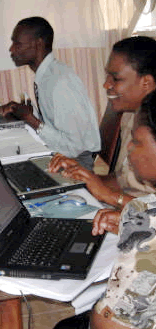

What Happens in Problem Based Learning (PBL)?
The PBL approach used in the Midwifery Certificate Programme is adapted to cater for the needs
of midwifery students in Malawi. It is a structured learning approach that is made up of these steps:
Overview of PBL |
|
Step 1: What is the problem? |
Individuals receive a written problem scenario and clarify the text of the scenario. Students define the problem. |
Step 2: What do we know already? |
Groups reflect on their experience and establish what they know. They use brainstorming to identify explanations for what is observed in the problem scenario. |
Step 3: What are the learning issues? |
Teams reach interim conclusions about the problem. They identify what new knowledge and skills they have to learn in order to respond appropriately to the scenario. They compile a learning plan that gives detailed descriptions of the learning issues. |
Step 4: What are my learning goals? |
Students work independently with the core learning resources and use the questions to guide their interactions with these resources. |
Step 5: What are we learning? |
Teams meet to share their insights and knowledge is built cooperatively. Student teams meet as often as needed. |
Step 6: What conclusions have we reached? |
Teams reflect critically on their understanding of the concepts. They apply their new knowledge and insights to the original scenario |
Step 7: What have we learned about learning? |
Teams reflect on their group and individual learning experiences. They identify what worked well and where and how they could improve in future. |

Orientation
-----------------------------------
1. What is PBL?
2. Benefits of PBL
3. PBL steps
4. PBL roles
5. Assessment strategy
6. What is a portfolio?
7. What is in the portfolio?
8. Assessment criteria
9. Portfolio guidelines
-----------------------------------
Open as a Word Document